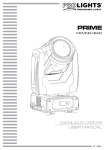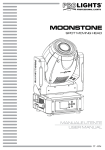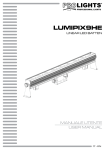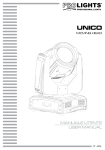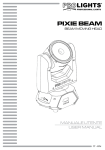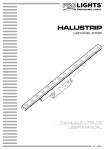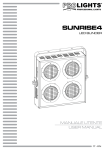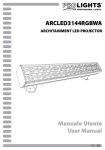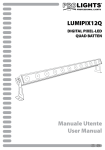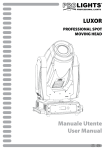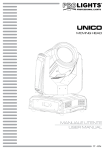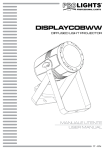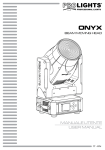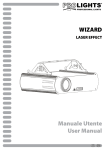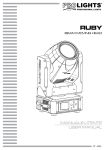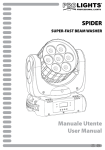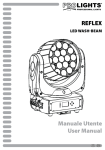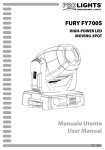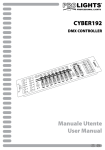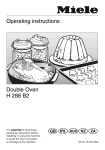Download prime
Transcript
PRIME MOVING HEAD MANUALE UTENTE USER MANUAL IT - EN Music & Lights S.r.l. si riserva ogni diritto di elaborazione in qualsiasi forma delle presenti istruzioni per l’uso. La riproduzione - anche parziale - per propri scopi commerciali è vietata. Al fine di migliorare la qualità dei prodotti, la Music&Lights S.r.l. si riserva la facoltà di modificare, in qualunque momento e senza preavviso, le specifiche menzionate nel presente manuale di istruzioni. Tutte le revisioni e gli aggiornamenti sono disponibili nella sezione 'Manuali' sul sito www.musiclights.it REV.002-10/13 PRIME INDICE Sicurezza Avvertenze generali Attenzioni e precauzioni per l’installazione Informazioni generali 4 4 5 1 Introduzione 1. 1 Descrizione 1. 2 Specifiche tecniche 1. 3 Elementi di comando e di collegamento 6 6 8 2 Installazione 2. 1 Lampada 2. 2 Installazione o sostituzione lampada 2. 3 Montaggio 10 10 12 3 Funzioni e impostazioni 3. 1 Funzionamento 3. 2 Impostazione base 3. 3 Struttura menu 3. 4 Modalità DMX 3. 5 Configurazione e indirizzamento DMX 3. 6 Visualizzazione del valore DMX 3. 7 Collegamenti della linea DMX 3. 8 Costruzione del terminatore DMX 3. 9 Canali DMX 3. 10 Impostazioni del proiettore 3. 11 Impostazioni lampada 3. 12 Impostazioni display 3. 13 Test su dispositivo 3. 14 Informazioni sul dispositivo 3. 15 Reset delle funzioni 3. 16 Funzioni speciali 3. 17 Regolazioni Home position 13 13 14 15 15 16 17 17 18 23 23 24 24 24 25 25 25 4 Manutenzione 4. 1 Manutenzione e pulizia del sistema ottico 4. 2 Sostituzione fusibile 4. 3 Risoluzione dei problemi 4. 4 Messaggi di errore 4. 5 Ruota gobo 26 26 27 27 28 Certificato di garanzia Contenuto dell'imballo: 3 • • • • • • PRIME Cavo di segnale Cavo di alimentazione Cavo di sicurezza Supporti omega (2pz.) Manuale utente PRIME 4 ATTENZIONE! Prima di effettuare qualsiasi operazione con l’unità, leggere con attenzione questo manuale e conservarlo accuratamente per riferimenti futuri. Contiene informazioni importanti riguardo l’installazione, l’uso e la manutenzione dell’unità. SICUREZZA Avvertenze generali • I prodotti a cui questo manuale si riferisce sono conformi alle Direttive della Comunità Europea e pertanto recano la sigla . • Il dispositivo funziona con pericolosa tensione di rete 230V~. Non intervenire mai al suo interno al di fuori delle operazioni descritte nel presente manuale; esiste il pericolo di una scarica elettrica. • È obbligatorio effettuare il collegamento ad un impianto di alimentazione dotato di un’efficiente messa a terra (apparecchio di Classe I secondo norma EN 60598-1). Si raccomanda, inoltre, di proteggere le linee di alimentazione delle unità dai contatti indiretti e/o cortocircuiti verso massa tramite l’uso di interruttori differenziali opportunamente dimensionati. • Le operazioni di collegamento alla rete di distribuzione dell’energia elettrica devono essere effettuate da un installatore elettrico qualificato. Verificare che frequenza e tensione della rete corrispondono alla frequenza ed alla tensione per cui l’unità è predisposta, indicate sulla targhetta dei dati elettrici. • L’unità non per uso domestico, solo per uso professionale. • Evitare di utilizzare l’unità: - in luoghi soggetti a vibrazioni, o a possibili urti; - in luoghi a temperatura superiore ai 40°C. • Evitare che nell’unità penetrino liquidi infiammabili, acqua o oggetti metallici. • Non smontare e non apportare modifiche all’unità. • Tutti gli interventi devono essere sempre e solo effettuati da personale tecnico qualificato. Rivolgersi al più vicino centro di assistenza tecnica autorizzato. • Se si desidera eliminare il dispositivo definitivamente, consegnarlo per lo smaltimento ad un’istituzione locale per il riciclaggio. Attenzioni e precauzioni per l’installazione • Questo prodotto è solo per uso interno. Per prevenire il rischio di incendi o scosse elettriche, non esporre il prodotto alla pioggia o all’umidità. • Se il dispositivo dovesse trovarsi ad operare in condizioni differenti da quelle descritte nel presente manuale, potrebbero verificarsi dei danni; in tal caso la garanzia verrebbe a decadere. Inoltre, ogni altra operazione potrebbe provocare cortocircuiti, incendi, scosse elettriche, rotture etc. • Prima di iniziare qualsiasi operazione di manutenzione o pulizia sull’unità togliere la tensione dalla rete di alimentazione. • È assolutamente necessario proteggere l’unità per mezzo di una fune di sicurezza. Nell’eseguire qualsiasi intervento attenersi scrupolosamente a tutte le normative (in materia di sicurezza) vigenti nel paese di utilizzo. • La temperatura massima raggiungibile sulla superficie esterna dell’unità, in condizioni di regime termico, è di 85°C. Non toccare l’involucro durante il funzionamento potrebbe essere molto caldo. Attendere 15 minuti finché l’unità non si sia raffreddata prima di effettuare interventi di manutenzione o sostituzione lampada. • Assicurarsi che l’unità sia spenta e che la temperatura delle parti non possa provocare ustioni. • Sostituire immediatamente la lampada se danneggiata, deformata dal calore o esaurita. • Se è necessario sostituire la lampada, utilizzare un guanto che non lasci pelucchi; evitare contatto diretto con le mani. • Installare l’unità in un luogo ben ventilato. La distanza minima tra il dispositivo e le pareti circostanti deve essere almeno di 50 cm. PRIME 5 • Al fine di proteggere l’unità da surriscaldamento, le ventole di raffreddamento (e nel caso) le aperture di ventilazione, non devono essere ostruite. • L’unità deve essere posizionata in modo tale che gli oggetti colpiti dal fascio luminoso siano distanti almeno 12 m da essa. • Mantenere i materiali infiammabili ad una distanza di sicurezza dall’unità. • I filtri, le lenti o gli schermi ultravioletti se danneggiati possono limitare la loro efficienza. • Non sollevare il proiettore afferrandolo per parte mobile (testa). • Non guardare direttamente il fascio luminoso. Tenete presente che i veloci cambi di luce possono provocare attacchi d’epilessia presso persone fotosensibili o epilettiche. • Non collegare il proiettore a un dimmer pack. INFORMAZIONI GENERALI Spedizioni e reclami Le merci sono vendute “franco nostra sede” e viaggiano sempre a rischio e pericolo del distributore/cliente. Eventuali avarie e danni dovranno essere contestati al vettore. Ogni reclamo per imballi manomessi dovrà essere inoltrato entro 8 giorni dal ricevimento della merce. Garanzie e resi Il prodotto è coperto da garanzia in base alle vigenti normative. Sul sito www.musiclights.it è possibile consultare il testo integrale delle “Condizioni Generali di Garanzia”. Si prega, dopo l’acquisto, di procedere alla registrazione del prodotto sul sito www.musiclights.it. In alternativa il prodotto può essere registrato compilando e inviando il modulo riportato alla fine del manuale. A tutti gli effetti la validità della garanzia è avallata unicamente dalla presentazione del certificato di garanzia. Music & Lights constata tramite verifica sui resi la difettosità dichiarata, correlata all’appropriato utilizzo, e l’effettiva validità della garanzia; provvede quindi alla riparazione dei prodotti, declinando tuttavia ogni obbligo di risarcimento per danni diretti o indiretti eventualmente derivanti dalla difettosità. 6 PRIME - 1 - INTRODUZIONE 1.1 DESCRIZIONE PRIME è un moving BEAM straordinariamente compatto e leggero, con lampada Platinum 2R da 132 Watt, resa luminosa e prestazioni tipiche di proiettori con lampade Platinum di potenza nominale superiore. Ultra potente, leggero e silenzioso, è stato progettato per emettere un fascio di luce puro e concentrato, super parallelo ed halo-free. PRIME apre le porte ad un nuovo livello di libertà creativa nella generazione di effetti di fasci nell’aria, offrendo 14 colori, 18 gobos, focus, prisma rotante 8 facce, prisma rotante lineare 6 facce, strobo e shutter. L’estrema velocità e precisione nei movimenti è garantita dalla struttura del telaio ultra-leggero e dall’impiego di motori 3step, rendendolo comparabile alla velocità degli scanner. Questo nuovo proiettore è ideale per i Lighting Designer, che potranno aumentare i punti luce nei propri progetti senza incrementare gli investimenti e per le Rental Company che potranno disporre di un beam di piccole dimensioni ma con alte performance e ridotti costi di gestione per consumi, trasporti, stoccaggio e cambio lampada (6000hr lifetime 2R). 1.2 SPECIFICHE TECNICHE Sorgente luminosa • MSD Platinum 2R Philips da 132W • Temperatura colore: 8000 K • Flusso luminoso: 5150 lm • Vita media: 6000h Ottica • Gruppo ottico composto da lente in vetro HQ • Angolo di proiezione: 3° • Riflettore parabolico incorporato nella lampada per garantire estrema uniformità e precisione • Focus: elettronico • Emissione luminosa: 22’000 lux @ 20mt Dimmer / shutter / strobo • Dimmer lineare 0-100% • Shutter indipendente ed effetti di dissolvenza a velocità variabile • Strobo: meccanico 8 flash/s, (effetto strobo random) Sistema colori • Ruota colori con 14 filtri dicroici + bianco (selezione lineare-stepless) • Ruota colori dotata di doppio filtro CTO (3200K + 5600K) e filtro UV • Effetto rainbow in entrambe le direzioni Effetti • Gruppo gobos composto da 17 gobos metallici • Effetto “gobo-shake” selezionabile • Cambio gobo con blackout sincronizzato • Gruppo gobos di facile accesso • Prisma circolare a otto facce con rotazione bidirezionale a velocità variabile • Prisma lineare a sei facce con rotazione bidirezionale a velocità variabile PRIME 7 Elettronica • Display grafico LCD per accesso semplificato al menu di controllo, configurazione e assegnazione indirizzo • 2 configurazioni DMX disponibili: 14/16 canali per ampia flessibilità di controllo • Segnale di ingresso ed uscita tramite connettori XLR 3p e 5p • Modalità “ENERGYSAVE”: consumo ridotto del 50% con il proiettore in blackout • Controllo ON/OFF della lampada in remoto • Reset delle funzioni da controllo remoto • Check-up e test elettronico per diagnostica • Timer ore di vita della lampada • Sensore termico per il monitoraggio della temperatura ottimale di lavoro della lampada • Raffreddamento ad aria filtrata forzata con ventole silenziate a velocità regolabile Struttura e corpo mobile • Struttura in alluminio con coperture in policarbonato ad alta resistenza, colore nero • Maniglie ergonomiche laterali per il trasporto • Motori 3step per movimenti ultra-veloci e precisi • Escursione: Pan = 540° Tilt = 270° • Risoluzione Pan/Tilt: 8-bit o 16-bit Pan = 2,10° Pan Fine = 0,008° Tilt = 1,05° Tilt Fine = 0,004° • Riposizionamento automatico degli effetti in seguito a spostamenti accidentali • Sospensione e fissaggio: qualsiasi posizione per mezzo di supporti omega (inclusi) con sistema di aggancio “quicklock” Alimentazione • Ballast elettronico ed alimentatore switching universale 100-240V 50/60Hz • Connessioni: PowerCON IN/OUT • Output alimentazione per connessione di più unità in serie: fino a 8 proiettori a 230V • Consumo energetico: 250W 476 Peso e Dimensioni • Peso: 15 kg • Dimensioni (LxAxP): 310x476x256 mm 310 256 Fig.1 PRIME 8 1.3 ELEMENTI DI COMANDO E COLLEGAMENTI 1 2 B A 3 4 6 7 POWER MENU ENTER DMX Pannello A Pannello B 5 8 9 10 11 12 13 14 Fig.2 PRIME 1. 2. 3. 4. 5. 6. 7. TESTA MOBILE BRACCIO GIREVOLE MANIGLIA PER TRASPORTO INDICATORE LED "Power On" INDICATORE LED "DMX input present" DISPLAY LCD PANNELLO DI CONTROLLO con 4 pulsanti per l'accesso e gestione delle diverse funzioni: -- Tasto MENU per selezionare il menu d'impostazione o tornare ad un livello del menu precedente. -- Tasto UP per scorrere attraverso le diverse funzioni in ordine crescente o aumentare il valore della funzione stessa. -- Tasto DOWN per scorrere attraverso le diverse funzioni in ordine decrescente o diminuire il valore della funzione stessa. -- Tasto ENTER per entrare nel menu selezionato o confermare un impostazione del menu. 9 8. DMX IN (XLR a 3 poli): 1 = massa, 2 = DMX -, 3 = DMX + 9. DMX OUT (XLR a 3 poli): 1= massa, 2 = DMX -, 3 = DMX + 10. DMX IN (XLR a 5 poli): 1 = massa, 2 = DMX -, 3 = DMX +, 4 N/C, 5 N/C 11. DMX OUT (XLR a 5 poli): 1= massa, 2 = DMX -, 3 = DMX +, 4 N/C, 5 N/C 12. POWER IN ( PowerCON IN): per il collegamento ad una presa di rete (100-240V~/50-60Hz) tramite il cavo rete in dotazione. 13. POWER OUT ( PowerCON OUT): collegamento per l'alimentazione all'unità successiva. 14. PORTAFUSIBILE: sostituire un fusibile difettoso solo con uno dello stesso tipo. 10 PRIME - 2 - INSTALLAZIONE 2.1 LAMPADA Si raccomanda l’uso di lampade MSD Platinum 2R Philips da 132W. Assicurarsi che la lampada sia compatibile con il voltaggio dell’impianto elettrico usato. Se lampada viene fatta operare con un voltaggio superiore al suo voltaggio nominale potrebbe essere danneggiata o la sua durata notevolmente ridotta. 2.2 INSTALLAZIONE O SOSTITUZIONE LAMPADA • A causa della sua elevata pressione interna ci potrebbe essere il rischio che la lampada a scarica esploda durante il funzionamento. La lampada emette radiazioni UV, dannose per gli occhi e la pelle. Non guardare direttamente il fascio luminoso poiché l’elevata luminosità può causare gravi danni alla retina. • La lampada genera radiazione UV. Non utilizzare mai la lampada senza un’adeguata schermatura. • Per proteggere la lampada, impostare lo spegnimento della stessa (tramite controller DMX o pannello di controllo) e lasciare in esecuzione l’unità per almeno 5 minuti affinché si raffreddi, prima di disconnettere l’alimentazione. Non toccare mai la lampada quando è calda. • Non toccare la lampada a mani nude. Prima dell’installazione pulire la lampada con alcool denaturato e con un panno morbido. • Quando accesa la lampada opera ad alta pressione e c’è un piccolo rischio di rottura. Il rischio aumenta con il tempo, la temperatura e con l’uso improprio. Non usare la lampada oltre la sua durata. • Assicurarsi che la lampada sia situata al centro del riflettore per la migliore proiezione. Per installare la lampada, osservare le seguenti istruzioni: 1. Disconnettere l’unità dall’alimentazione. Per accedere alla lampada situata nella parte posteriore smontare la testa mobile svitando le viti della cover. Poi estrarre la ventola svitando le relativi viti (fig.3). Fig.3 PRIME 11 2. Nel caso di sostituzione della lampada rimuovere la vecchia lampada dalla sua sede afferrandola alla base dopo aver scollegato i cavi. 3. Non toccare il bulbo della lampada a mani nude, se ciò accade, pulire la lampada con alcool denaturato ed asciugare con un panno che non lasci pelucchi. Afferrare la nuova lampada alla base (non al bulbo) e fissarla nella sede. 4. Ripristinare tutte le parti nella posizione originale. Fig.4 PRIME 12 2.3 MONTAGGIO Fig.5 Il PRIME può essere collocato su un piano solido. Inoltre, grazie ai fori di fissaggio, l’unità può essere montata anche a testa in giù, su una traversa (fig.5). Per il fissaggio occorrono dei supporti robusti per il montaggio. Come si vede nell’illustrazione, i perni del sistema di aggancio rapido, dei supporti omega, sono da inserire nelle apposite sedi della piastra dove vengono bloccati con una rotazione in senso orario (fino all’arresto). L’area di collocazione deve avere una stabilità sufficiente e supportare almeno 10 volte il peso dell’unità. Inoltre assicurarsi di rispettare tutte le avvertenze in materia di sicurezza. È assolutamente necessario assicurare il proiettore contro la caduta utilizzando un cavo di sicurezza: in particolare collegare il cavo in un punto adatto in modo che la caduta del proiettore non possa superare i 20 cm. Assicurarsi che l’unità sia saldamente fissata al fine di evitare vibrazioni e scivolamenti durante il funzionamento. CAVO DI SICUREZZA GANCIO ALISCAFF SUPPORTI OMEGA Fig.6 PRIME 13 - 3 - FUNZIONI E IMPOSTAZIONI 3.1 FUNZIONAMENTO Per accendere il PRIME inserire la spina del cavo di alimentazione in una presa di rete (100-240V~/5060Hz). La testa mobile e tutti i motori di comando si mettono in una precisa posizione di partenza. Poco dopo l’unità è pronta. Per spegnere il PRIME, staccare la spina dalla presa di rete. Per maggiore comodità è consigliabile collegare l’unità con una presa comandata da un interruttore. 3.2 IMPOSTAZIONE BASE Il proiettore PRIME dispone di un display LCD e di 4 pulsanti per l’accesso alle funzioni del pannello di controllo e la loro gestione (fig.7). POWER MENU ENTER DMX MENU ENTER Per scorrere il menu principale o tornare ad una opzione del menu precedente Per entrare nel menu selezionato o confermare il valore attuale della funzione o l'opzione all'interno di un menu UP Per scorrere attraverso le diverse funzioni in ordine ascendente o aumentare il valore della funzione stessa DOWN Per scorrere attraverso le diverse funzioni in ordine discendente o diminuire il valore della funzione stessa Fig.7 - Funzione dei tasti PRIME 14 3.3 STRUTTURA MENU DMX FUNCTIONS DMX Address 001 - 512 DMX Value Mode1 (16) - Mode2 (14) View DMX Value FIXTURE SETTING LAMP SETTING DISPLAY SETTING FIXTURE TEST Pan Inverse No / Yes Tilt Inverse No / Yes P/T Feedback No / Yes BI.o. P/T Moving No / Yes BI.o. Color Change No / Yes BI.o. Gobo Change No / Yes On/Off Off / On State/ Power On Off / On Off via DMX No / Yes On if DMX on No / Yes Off if DMX Off No / Yes Ignition Delay 0 - 255s Low Power Delay 0 - 255s Display Inverse No / Yes Backlight Auto Off No / Yes Backlight Intensity 1 - 10 Contrast Ratio 1 - 30 Temperature Unit °C / °F Display Warning No / Yes Auto Test Manual Test Fixture use time FIXTURE INFORMATION Lamp On time Exit / Reset Time Fireware Version RESET FUNCTION Pan / Tilt No / Yes Shutter / Prism No / Yes PRIME RESET FUNCTION SPECIAL FUNCTIONS 15 Color No / Yes Gobo No / Yes Focus No / Yes All No / Yes Fixture Maintenance Interval / Remain Time Factory Settings No / Yes 3.4 MODALITÀ DMX Per entrare nella modalità DMX procedere nel seguente modo: • Premere il tasto MENU e selezionare attraverso i tasti direzionali la voce [DMX FUNCTIONS], quindi premere il tasto ENTER per confermare la scelta. • Selezionare nel menu la voce [DMX Address] e confermare la scelta premendo il tasto ENTER. • Modificare il valore DMX nell’intervallo [1 - 512] servendosi dei tasti direzionali. • Per confermare il valore dell’indirizzo DMX premere il tasto ENTER. • Premere il tasto MENU per tornare indietro o attendere un minuto per uscire dal menu di impostazione. 3.5 CONFIGURAZIONE E INDIRIZZAMENTO DMX Il PRIME dispone di 2 configurazioni di canali DMX (Mode1 e Mode2) che possono essere impostate dal pannello di controllo nel modo seguente: • Premere il tasto MENU, selezionare attraverso i tasti direzionali la voce [DMX Functions] e premere il tasto ENTER per confermare. • Selezionare la voce [DMX Channel Mode] e confermare la scelta premendo il tasto ENTER. • Selezionare la modalità DMX desiderata fra [Mode1(16Ch)] e [Mode2(14Ch)] e premere il tasto ENTER. Le tabelle a pagina 18 indicano le modalità di funzionamento e i relativi valori DMX. Come interfaccia DMX, l’unità possiede dei contatti XLR a 3 poli e 5 poli. Per poter comandare il PRIME con un’unità di comando luce, occorre impostare l’indirizzo di start DMX per il primo canale DMX. Se, per esempio, sull’unità di comando è previsto l’indirizzo 33 per comandare la funzione del primo canale DMX, si deve impostare sul PRIME l’indirizzo di start 33. Le altre funzioni del pannello saranno assegnate automaticamente agli indirizzi successivi. Segue un esempio con indirizzo 33 di start: Numero canali DMX Indirizzo di start (esempio) Indirizzo DMX occupati Prossimo indirizzo di start possibile per unità n°1 Prossimo indirizzo di start possibile per unità n°2 Prossimo indirizzo di start possibile per unità n°3 14 33 33-46 47 61 75 16 33 33-48 49 65 81 PRIME 16 DMX Address: 33 DMX Address: 49 DMX Address: 65 DMX Address: 81 . . . . . . . . . . . . DMX512 Controller Fig.8 - Esempio di configurazione a 16 canali DMX 3.6 VISUALIZZAZIONE DEL VALORE DMX È possibile visualizzare sul display il valore DMX e la funzione ad esso associata nel seguente modo: • Premere il tasto MENU, selezionare la voce [DMX FUNCTIONS] e premere il tasto ENTER per confermare. • Selezionare la voce [View DMX Value] e confermare la scelta premendo il tasto ENTER. • Utilizzare i tasti direzionali per scorrere le voci risultanti. • Premere il tasto MENU per tornare indietro o attendere un minuto per uscire dal menu di impostazione. PRIME 17 3.7 COLLEGAMENTI DELLA LINEA DMX La connessione DMX è realizzata con connettori standard XLR. Utilizzare cavi schermati, 2 poli ritorti, con impedenza 120Ω e bassa capacità. Per il collegamento fare riferimento allo schema di connessione riportato di seguito: DMX - INPUT Spina XLR DMX - OUTPUT Presa XLR Pin1 : Massa - Schermo Pin2 : - Negativo Pin3 : + Positivo Pin4 : N/C Pin5 : N/C Fig.9 ATTENZIONE La parte schermata del cavo (calza) non deve mai essere collegata alla terra dell’impianto; ciò comporterebbe malfunzionamenti delle unità e dei controller. Per passaggi lunghi può essere necessario l’inserimento di un amplificatore DMX. In tal caso, è sconsigliato utilizzare nei collegamenti cavo bilanciato microfonico poiché non è in grado di trasmettere in modo affidabile i dati di controllo DMX. • Collegare l’uscita DMX del controller con l’ingresso DMX della prima unità; • Collegare, quindi, l’uscita DMX con l’ingresso DMX della successiva unità; l’uscita di quest’ultima con l’ingresso di quella successiva e via dicendo finchè tutte le unità sono collegate formando una catena. • Per installazioni in cui il cavo di segnale deve percorrere lunghe distanze è consigliato inserire sull’ultima unità una terminazione DMX. 3.8 COSTRUZIONE DEL TERMINATORE DMX La terminazione evita la probabilità che il segnale DMX 512, una volta raggiunta la fine della linea stessa venga riflesso indietro lungo il cavo, provocando, in certe condizioni e lunghezze, la sua sovrapposizione al segnale originale e la sua cancellazione. La terminazione deve essere effettuata, sull’ultima unità della catena, con connettori XLR a 3/5 pin, saldando una resistenza di 120Ω (minimo 1/4W) tra i terminali 2 e 3, così come indicato in figura. Esempio: connettore XLR a 3 pin Fig.10 PRIME 18 3.9 CANALI DMX MODE 16 Ch 14 Ch FUNCTION DMX Value 1 1 PAN 0° - 540° 000 - 255 2 * PAN FINE 000 - 255 3 2 TILT 0° - 220° 000 - 255 4 * TILT FINE 000 - 255 5 3 P/T SPEED Fast - Slow 000 - 255 4 SPECIAL FUNCTIONS Open Dimmer conventional Mode Dimmer linear Mode P/T fast Mode P/T normal Mode Enable blackout while P/T moving Disable blackout while P/T moving Enable blackout while Color changing Disable blackout while Color changing Enable blackout while Gobo changing Disable blackout while Gobo changing Lamp On Pan/Tilt Reset Color Reset Gobo Reset Shutter/Prism Reset No Function Focus Reset Reset All Enable blackout while P/T moving or Color/ Gobo changing Disable blackout while P/T moving or Color/ Gobo changing Lamp Off Open 6 7 5 P/T MACRO Off Macro 1 Macro 2 Macro 3 Macro 4 Macro 5 Macro 6 000 - 029 030 - 039 040 - 049 050 - 059 060 - 069 070 - 079 080 - 089 090 - 099 100 - 109 110 - 119 120 - 129 130 - 139 140 - 149 150 - 159 160 - 169 170 -179 180 - 189 190 - 199 200 - 209 210 - 219 220 - 229 230 - 239 240 - 255 000 - 007 008 - 015 016 - 023 024 - 031 032 - 039 040 - 047 048 - 055 PRIME MODE 16 Ch 14 Ch FUNCTION 7 5 Macro 7 Macro 8 Macro 9 Macro 10 Macro 11 Macro 12 Macro 13 Macro 14 Macro 15 Macro 16 Macro 17 Macro 18 Macro 19 Macro 20 Macro 21 Macro 22 Macro 23 Macro 24 Macro 25 Macro 26 Macro 27 Macro 28 Macro 29 Macro 30 Macro 31 8 6 P/T MACRO SPEED Fast - Slow 7 COLOR White White + Color 1 Color 1 Color 1 + Color 2 Color 2 Color 2 + Color3 Color 3 Color 3 + Color 4 Color 4 olor 4 + Color 5 Color 5 Color 5 + Color 6 Color 6 Color 6 + Color 7 Color 7 Color 7 + Color 8 Color 8 9 19 DMX Value 056 - 063 064 - 071 072 - 079 080 - 087 088 - 095 096 - 103 104 - 111 112 - 119 120 - 127 128 - 135 136 - 143 144 - 151 152 - 159 160 - 167 168 - 175 176 - 183 184 - 191 192 - 199 200 - 207 208 - 215 216 - 223 224 - 231 232 - 239 240 - 247 248 - 255 000 - 255 000 - 002 003 - 004 005 - 006 007 - 008 009 - 010 011 - 012 013 - 014 015 - 016 017 - 018 019 - 021 022 - 023 024 - 025 026 - 027 028 - 029 030 - 031 032 - 033 034 - 035 PRIME 20 MODE 16 Ch 14 Ch 9 10 FUNCTION DMX Value 7 Color 8 + Color 9 Color 9 Color 9 + Color 10 Color 10 Color 10 + Color 11 Color 11 Color 11 + Color 12 Color 12 Color 12 - Color 13 Color 13 Color 13 + Color 14 Color 14 Color 14 + White Color Index Clockwise rotation Fast - Slow Stop Anticlockwise rotation Slow - Fast 036 - 037 038 - 039 040 - 042 043 - 044 045 - 046 047 - 048 049 - 050 051 - 052 053 - 054 055 - 056 057 - 058 059 - 060 061 - 063 064 - 127 128 -189 190 - 193 194 - 255 8 GOBO Open Gobo 1 Gobo 2 Gobo 3 Gobo 4 Gobo 5 Gobo 6 Gobo 7 Gobo 8 Gobo 9 Gobo 10 Gobo 11 Gobo 12 Gobo 13 Gobo 14 Gobo 15 Gobo 16 Gobo 17 Open Shaking Gobo 1 Shaking Gobo 2 Shaking Gobo 3 Shaking Gobo 4 Shaking Gobo 5 Shaking Gobo 6 Shaking Gobo 7 Shaking Gobo 8 Shaking Gobo 9 Shaking 000 - 003 004 - 006 007 - 009 010 - 012 013 - 015 016 - 018 019 - 021 022 - 024 025 - 027 028 - 030 031 - 033 034 - 036 037 - 039 040 - 042 043 - 045 046 - 048 049 - 051 052 - 055 056 - 059 060 - 063 064 - 067 068 - 071 072 - 075 076 - 079 080 - 083 084 - 087 088 - 091 092 - 095 PRIME MODE 16 Ch 14 Ch 10 8 11 9 12 10 FUNCTION Gobo 10 Shaking Gobo 11 Shaking Gobo 12 Shaking Gobo 13 Shaking Gobo 14 Shaking Gobo 15 Shaking Gobo 16 Shaking Gobo 17 Shaking Clockwise rotation Fast - Slow Stop Anticlockwise rotation Slow - Fast PRISM 1 No Function Prism 1 Effect Rotation Effect 1 Rotation Effect 2 Rotation Effect 3 Rotation Effect 4 Rotation Effect 5 Rotation Effect 6 Rotation Effect 7 Rotation Effect 8 Rotation Effect 9 Rotation Effect 10 Rotation Effect 11 Rotation Effect 12 Rotation Effect 13 Rotation Effect 14 Rotation Effect 15 Rotation Effect 16 Rotation Effect 17 Rotation Effect 18 Rotation Effect 19 Rotation Effect 20 Rotation Effect 21 Rotation Effect 22 Rotation Effect 23 Rotation Effect 24 Rotation Effect 25 Rotation Effect 26 Rotation Effect 27 Rotation Effect 28 PRISM 2 No Function Prism 2 Effect No Function 21 DMX Value 096 - 099 100 - 103 104 - 107 108 - 111 112 - 115 116 - 119 120 - 123 124 - 127 128 - 189 190 - 193 194 - 255 000 - 007 008 - 127 128 - 132 133 - 137 138 - 141 142 - 146 147 - 150 151 - 155 156 - 159 160 - 164 165 - 168 169 - 173 174 - 177 178 - 182 183 - 187 188 - 191 192 - 196 197 - 200 201 - 205 206 - 209 210 - 214 215 - 218 219 - 223 224 - 227 228 - 232 233 - 236 237 - 241 242 - 246 247 - 250 251 - 255 000 - 007 008 - 127 128 - 255 PRIME 22 MODE 16 Ch 14 Ch FUNCTION 13 11 PRISM ROTATION Index Rotation Rotation Fast - Slow Stop Rotation Slow - Fast 14 12 FOCUS 0 - 100% 15 13 SHUTTER Blackout Open ### Slow open - Fast close Fast open - Slow close Slow open - Slow close Random Strobe Open 16 14 DIMMER 0 - 100% DMX Value 000 - 127 128 - 189 190 - 193 194 - 255 000 - 255 000 - 007 008 - 015 016 - 131 132 - 167 168 - 203 204 - 239 240 - 247 248 - 255 000 - 255 PRIME 23 3.10 IMPOSTAZIONI DEL PROIETTORE È possibile modificare i parametri relativi al dispositivo procedendo nel seguente modo: • Dal menu iniziale, premere il tasto MENU fino a quando sul display non appare [FIXTURE SETTING], quindi premere il tasto ENTER. • Selezionare l’opzione proposta con il tasto UP/DOWN e premere il tasto ENTER per confermare l’impostazione. -- [Pan Inverse] - Rotazione in senso opposto della testa mobile. [No] per disattivare la funzione (impostazione normale); [Yes] per attivare la funzione (Pan inverse). -- [Tilt Inverse] - Inclinazione in senso opposto della testa mobile. [No] per disattivare la funzione (impostazione normale), [Yes] per attivare la funzione (Tilt inverse). -- [P/T Feedback] - Feedback quando la posizione Pan/Tilt è fuori passo. Selezionare [No] per disattivare la funzione oppure [Yes] per attivare la funzione. -- [BI.o. P/T Moving] - Blackout quando Pan/Tilt sono in funzione. Selezionare [No] per disattivare la funzione oppure [Yes] per attivare la funzione. -- [BI.o. Color Change] - Blackout, mentre avviene il cambio colori. Selezionare [No] per disattivare la funzione oppure [Yes] per attivare la funzione. -- [BI.o. Gobo Change] - Blackout, mentre avviene il cambio gobos. Selezionare [No] per disattivare la funzione oppure [Yes] per attivare la funzione. • Premere il tasto MENU per tornare indietro o attendere qualche secondo per uscire dal menu di impostazione. 3.11 IMPOSTAZIONI LAMPADA È possibile modificare i parametri relativi alla lampada del dispositivo procedendo nel seguente modo: • Dal menu iniziale, premere il tasto MENU fino a quando sul display non appare [LAMP SETTING], quindi premere il tasto ENTER. • Selezionare l’opzione proposta con il tasto UP/DOWN e premere il tasto ENTER per confermare l’impostazione. -- [On/Off] - Accensione o spegnimento della lampada dal pannello comandi. Selezionare [Off] per spegnimento lampada; [On] per accensione lampada. -- [State/ Power On] - Stato della lampada quando l’unità e in funzione. Selezionare [Off] per spegnimento lampada quando l’unità e in funzione; [On] per accensione lampada quando l’unità e in funzione. -- [Off via DMX] - Abilitazione del canale di controllo remoto della lampada. Selezionare [No] per disattivare la funzione oppure [Yes] per attivare la funzione. -- [On if DMX on] - Accensione lampada quando viene rilevato il segnale DMX. Selezionare [No] per disattivare la funzione oppure [Yes] per attivare la funzione. -- [Off if DMX Off] - Spegnimento lampada quando si interrompe il segnale DMX. Selezionare [No] per disattivare la funzione oppure [Yes] per attivare la funzione. -- [Ignition Delay] - Tempo di ritardo tra alimentazione e accensione lampada. Selezionare il valore [0 255s]. -- [Low Power Delay] - Tempo di ritardo che intercorre tra chiusura shutter/dimmer e riduzione alimentazione lampada. Selezionare il valore [0 - 255s]. • Premere il tasto MENU per tornare indietro o attendere qualche secondo per uscire dal menu di impostazione. 24 PRIME 3.12 IMPOSTAZIONI DISPLAY È possibile modificare i seguenti parametri, relativi al display, seguendo la medesima procedura: • Premere il tasto MENU e selezionare attraverso i tasti direzionali la voce [DISPLAY SETTING], quindi premere il tasto ENTER. • Selezionare l’opzione proposta con il tasto UP/DOWN e premere il tasto ENTER per confermare l’impostazione. -- [Display inverse] - Orientamento del display. Usare i tasti direzionali per selezionare l’impostazione display normale [No] oppure [Yes] per la visualizzazione inversa. -- [Backlight Auto Off] - Retroilluminazione display Auto Off. Usare i tasti direzionali per selezionare l’impostazione display sempre acceso [No] oppure [Yes] per l’impostazione display spento 1 minuto dopo uscita dal menu. -- [Backlight Intensity] - Intensità retroilluminazione. Usare i tasti direzionali per selezionare un valore da 1-10. -- [Contrast Ratio] - Intensità contrasto. Usare i tasti direzionali per selezionare un valore da 1 (scuro) a 30 (chiaro). -- [Temperature Unit] - Scala di temperatura. Questa funzione permette di scegliere la scala di temperatura tra °C e °F. -- [Display Warning] - Avviso di errore. Usare i tasti direzionali per selezionare [No] oppure [Yes] a seconda che si voglia o meno che il display mostri avvisi di errore. • Premere il tasto MENU per tornare indietro o attendere qualche secondo per uscire dal menu di impostazione. 3.13 TEST SU DISPOSITIVO Auto Test Permette di verificare il corretto funzionamento dell’unità. Per avviare il test procedere nel seguente modo: • Premere il tasto MENU e selezionare attraverso i tasti direzionali la voce [FIXTURE TEST], quindi selezionare [Auto Test]. • Per confermare e dare l’avvio al test automatico premere il tasto ENTER. Manual Test Permette di eseguire tramite pannello comandi delle regolazioni sugli effetti per ottenere una perfetta uniformità tra i proiettori. • Premere il tasto MENU e selezionare attraverso i tasti direzionali la voce [FIXTURE TEST], quindi selezionare [Manual Test] e premere il tasto ENTER per confermare la scelta. • Selezionare l’effetto sul quale si desidera eseguire la regolazione e confermare premendo il tasto ENTER. • Eseguire la calibratura dell’effetto attraverso i tasti direzionali impostando un valore tra [0 - 255] e premere il tasto ENTER per confermare l’impostazione. 3.14 INFORMAZIONI SUL DISPOSITIVO • Dal menu iniziale, premere il tasto MENU e selezionare con i tasti direzionali [FIXTURE INFORMATION]. Premere il tasto ENTER per confermare l’impostazione. -- [Fixture use time] - Attraverso la funzione [Fixture use time] è possibile visualizzare sul display il tempo di funzionamento del proiettore. -- [Lamp On Time] - Attraverso la questa funzione è possibile visualizzare sul display il tempo di funzionamento della lampada. Premere [Exit] per uscire o [Reset Time] per effettuare l’azzeramento. -- [Firmaware Version] - Attraverso la funzione [Firmaware Version] è possibile visualizzare sul display la versione del software installata. PRIME 25 3.15 RESET DELLE FUNZIONI È possibile avviare un programma preimpostato per ripristinare la funzione selezionata alla sua impostazione “Home Position”.: • Premere il tasto MENU e selezionare attraverso i tasti direzionali la voce [RESET FUNCTION]. Premere il tasto ENTER per confermare la scelta. • Selezionare la funzione che si desidera resettare fra [Pan/Tilt, Shutter/Prism, Color, Gobo, Focus e All]. Premere il tasto ENTER per confermare la scelta. • Servendosi dei tasti UP e DOWN, selezionare [Yes] oppure [No] a seconda che si vogliano o meno ripristinare le condizioni “Home position” della funzione scelta. 3.16 FUNZIONI SPECIALI • Premere il tasto MENU e selezionare attraverso i tasti direzionali la voce [SPECIAL FUNCTION]. • Per confermare premere il tasto ENTER. È possibile accedere alle seguenti informazioni: Fixture Maintenance • Selezionare attraverso i tasti direzionali la voce [Fixture Maintenance]. Premere il tasto ENTER per confermare la scelta. • Selezionare dunque [Interval] e premere il tasto ENTER se si vuole visualizzare sul display l’intervallo di tempo tra due interventi relativi alla manutenzione. Premere il tasto MENU per tornare indietro. • Selezionare [Remain Time] e premere il tasto ENTER se si vuole visualizzare sul display il tempo rimanente. Premere il tasto MENU per tornare indietro. • Selezionare attraverso i tasti direzionali [Exit] o [Reset time], a seconda che si voglia uscire dal menu o resettare il contatore. Premere il tasto ENTER per confermare la scelta. Factory Settings Permette di ripristinare l’unità alle impostazioni di fabbrica. • Selezionare attraverso i tasti direzionali la voce [Factory setting]. Premere il tasto ENTER per confermare la scelta. • Attraverso i tasti direzionali, selezionare [No] per mantenere le impostazioni attuali oppure [Yes] se si desidera ripristinare le impostazioni di fabbrica e uscire dal menu. 3.17 REGOLAZIONI HOME POSITION Per effettuare la preimpostazione dei valori correttivi (modalità offset): • Premere il tasto MENU e poi tenere premuto per circa 3 secondi il tasto ENTER. • Selezionare la funzione desiderata attraverso i tasti direzionali, quindi premere ENTER per confermare • la scelta. • Impostare, servendosi dei tasti UP e DOWN, il valore per la funzione. L’intervallo dei valori possibili per ogni funzione è riportato nella tabella di seguito. • Premere il tasto ENTER per confermare l’impostazione e tornare automaticamente all’ultimo menu. OFFSET MENU Pan Tilt Shutter Color Gobo Prism 1 Prism 2 R-Prism Focus -128 ~ 127 -128 ~ 127 0 ~ 255 -128 ~ 127 -128 ~ 127 0 ~ 255 0 ~ 255 -128 ~ 127 0 ~ 255 26 PRIME - 4 - MANUTENZIONE 4.1 MANUTENZIONE E PULIZIA DEL SISTEMA OTTICO • Durante gli interventi, assicurarsi che l’area sotto il luogo di installazione sia libera da personale non qualificato. • Spegnere l’unità, scollegare il cavo di alimentazione ed aspettare finché l’unità non si sia raffreddata. • Tutte le viti utilizzate per l’installazione dell’unità e le sue parti dovrebbero essere assicurate saldamente e non dovrebbero essere corrose. • Alloggiamenti, elementi di fissaggio e di installazione (soffitto, truss, sospensioni) dovrebbero essere totalmente esenti da qualsiasi deformazione. • Quando una lente ottica è visibilmente danneggiata a causa di rotture o graffi profondi, deve essere sostituita. • I cavi di alimentazione devono essere in condizione impeccabile e dovrebbero essere sostituiti immediatamente nel momento in cui anche un piccolo problema viene rilevato. • Al fine di proteggere l’unità da surriscaldamento, le ventole di raffreddamento (e nel caso) le aperture di ventilazione, devono essere pulite mensilmente. Per mantenere funzionalità e rendimento ottimali per lungo tempo è indispensabile effettuare una pulizia periodica delle parti soggette all’accumulo di polveri e grassi. La frequenza con la quale effettuare le operazioni sotto indicate dipende da diversi fattori, quali la quantità di movimenti degli effetti e la qualità dell’ambiente di lavoro (umidità dell’aria, presenza di polvere, salsedine, ecc.). Per rimuovere lo sporco dal riflettore, dalle lenti e dai filtri usare un panno morbido inumidito di un qualsiasi liquido detergente per la pulizia del vetro. Annualmente si consiglia di sottoporre il proiettore a personale tecnico qualificato per una manutenzione straordinaria consistente almeno nelle seguenti operazioni: -- Pulizia generale delle parti interne. -- Ripristino della lubrificazione di tutte le parti soggette ad attrito tramite l’utilizzo di lubrificanti appropriati. -- Controllo visivo generale di componenti interni, cablaggio, parti meccaniche, ecc. -- Controlli elettrici, fotometrici e funzionali; eventuali riparazioni. Attenzione: consigliamo che la pulizia interna sia eseguita da personale qualificato! 4.2 SOSTITUZIONE FUSIBILE 1. Assicurarsi di scollegare il cavo di alimentazione del proiettore prima di sostituire un fusibile bruciato con uno dello stesso tipo e valore. 2. Con un cacciavite, rimuovere il portafusibile dalla sua sede (fig.11) e il fusibile bruciato dal suo supporto; sostituire il fusibile con uno identico per tipologia e valore (T 6.3 A). 3. Inserire il portafusibile al suo posto e ricollegare l’alimentazione. Fig.11 PRIME 27 4.3 RISOLUZIONE DEI PROBLEMI Anomalie Possibili cause Il proiettore non funziona • • • • Mancanza di alimentazione di rete Fusibile bruciato Impostazione errata dei canali DMX Lampada esaurita • • • • Verificare la presenza della tensione alimentazione Sostituire il fusibile con uno dello stesso tipo Verificare valori canali DMX Sostituire la lampada Bassa intensità di luce generale • • Lenti sporche Lente disallineata • • Pulire il dispositivo regolarmente Installare il gruppo ottico correttamente Il proiettore non è alimentato • • • Mancanza di alimentazione di rete Cavo di alimentazione danneggiato Alimentatore interno difettoso • • • Verificare la presenza della tensione alimentazione Controllare il cavo di alimentazione Sostituire l'alimentatore interno • Indirizzamento DMX errato • • • Cavo di segnale DMX difettoso Rimbalzo segnale DMX • • Controllare il pannello di controllo e l'indirizzamento delle unità Controllare il cavo di segnale DMX Installare una terminazione DMX come suggerito Il proiettore non risponde al DMX Controlli e rimedi Rivolgersi a un centro di assistenza tecnico autorizzato nel caso in cui il problema non sia riportato in tabella. 4.4 MESSAGGI DI ERRORE Messaggio Descrizione Lamp Startup Fail Appare quando non è presente la lampada o alcuni cavi sono danneggiati. Temperature Sense Error Appare quando la scheda di controllo della temperatura è danneggiata. Lamp Too Hot Power Off Lamp Too Hot Low Power Maintenance Fixture Lamp On Over 700 Hour Appare quando viene rilevata una temperatura superiore ai 110°C. Verificare che l’unità sia installata in un luogo ventilato oppure che le ventole e il rilevatore di temperatura funzionino correttamente. Appare quando viene rilevata una temperatura superiore ai 105°C; l’unità in esecuzione con un basso livello di potenza. Appare quando il tempo residuo di manutenzione diventa pari a 0 secondi; si prega di accedere alla modalità menu e di resettare il tempo. Appare quando la lampada è stata in funzione più di 700 ore, si prega di spegnere la lampada. Memory Initial Fail Appare quando l’IC di memoria è danneggiato. CPU‐B Error, CPU‐C Error, CPU‐D Error Questi messaggi appaiono quando la scheda PC o alcuni cavi sono danneggiati. Pan Reset Error, Dimmer Reset Fail, ecc. Questi messaggi possono apparire quando si accende l’unità o si effettua il reset. Significa che alcune parti sono danneggiate. Si prega di rivolgersi ad un centro di assistenza tecnica autorizzato. PRIME 28 4.5 RUOTA GOBO NOTA - Installare o cambiare la ruota gobo solo quando il dispositivo è spento. Fig.12 Note All rights reserved by Music & Lights S.r.l. No part of this instruction manual may be reproduced in any form or by any means for any commercial use. In order to improve the quality of products, Music&Lights S.r.l. reserves the right to modify the characteristics stated in this instruction manual at any time and without prior notice. All revisions and updates are available in the ‘manuals’ section on site www.musiclights.it PRIME TABLE OF CONTENTS Safety General instructions Warnings and installation precautions General information 2 2 3 1 Introduction 1. 1 Description 1. 2 Technical specifications 1. 3 Operating elements and connections 4 4 6 2 Installation 2. 1 Lamp 2. 2 Inserting or replacing the lamp 2. 3 Mounting 8 8 10 3 Functions and settings 3. 1 Operation 3. 2 Basic 3. 3 Menu structure 3. 4 DMX mode 3. 5 Configuration and DMX addressing 3. 6 View DMX value 3. 7 Connection of the DMX line 3. 8 Construction of the DMX termination 3. 9 DMX control 3. 10 Fixture setting 3. 11 Lamp setting 3. 12 Display setting 3. 13 Fixture test 3. 14 Fixture information 3. 15 Reset functions 3. 16 Special functions 3. 17 Home position adjust 11 11 12 13 13 14 15 15 16 21 21 22 22 22 23 23 23 4 Maintenance 4. 1 Maintenance and cleaning the unit 4. 2 Fuse replacement 4. 3 Trouble shooting 4. 4 Error information 4. 6 Gobo wheel 24 24 25 25 26 Warranty Packing content 1 • • • • • • PRIME Signal cable Power cable Safety cable Omega holder (2pc.) User manual PRIME 2 WARNING! Before carrying out any operations with the unit, carefully read this instruction manual and keep it with cure for future reference. It contains important information about the installation, usage and maintenance of the unit. SAFETY General instruction • The products referred to in this manual conform to the European Community Directives and are therefore marked with . • The unit is supplied with hazardous network voltage (230V~). Leave servicing to skilled personnel only. Never make any modifications on the unit not described in this instruction manual, otherwise you will risk an electric shock. • Connection must be made to a power supply system fitted with efficient earthing (Class I appliance according to standard EN 60598-1). It is, moreover, recommended to protect the supply lines of the units from indirect contact and/or shorting to earth by using appropriately sized residual current devices. • The connection to the main network of electric distribution must be carried out by a qualified electrical installer. Check that the main frequency and voltage correspond to those for which the unit is designed as given on the electrical data label. • This unit is not for home use, only professional applications. • Never use the fixture under the following conditions: - in places subject to vibrations or bumps; - in places with a temperature of over 40 °C. • Make certain that no inflammable liquids, water or metal objects enter the fixture. • Do not dismantle or modify the fixture. • All work must always be carried out by qualified technical personnel. Contact the nearest sales point for an inspection or contact the manufacturer directly. • If the unit is to be put out of operation definitively, take it to a local recycling plant for a disposal which is not harmful to the environment. Warnings and installation precautions • The unit for indoor use only. To prevent or reduce the risk of electrical shock or fire, do not expose the unit to rain or moisture. • If this device will be operated in any way different to the one described in this manual, it may suffer damage and the guarantee becomes void. Furthermore, any other operation may lead to dangers like short circuit, burns, electric shock, etc. • Before starting any maintenance work or cleaning the fixture, cut off power from the main supply. • Always additionally secure the projector with the safety rope. When carrying out any work, always comply scrupulously with all the regulations (particularly regarding safety) currently in force in the country in which the fixture’s being used. • The maximum temperature that can be reached on the external surface of the fitting, in a thermally steady state, is 85°C. Don’t touch the housing bare‐handed during its operation, and allow about 15 minutes for cooling the unit down before replacing bulb or maintenance as it could be very hot. • Make certain that the fixture is off and the temperature of the components cannot cause burns. • Do replace the bulb once it is damaged, deformed or life‐expired. • When fitting a lamp, always use gloves or soft lint free cloth never touch it with your bare hands. • The minimum distance between the fixture and surrounding walls must be more than 50 cm and the air vents at the housing must not be covered in any case. • Be sure that no ventilation slots are blocked; otherwise the unit will be overheated. • The projector needs to be positioned so that the objects hit by the beam of light are at least 12 m from the lens of the projector. PRIME 3 • • • • Keep any inflammable material at a safe distance from the fixture. The housing, the lenses, or the ultraviolet filter must be replaced if they are visibly damaged Don’t lift the fixture holding it by the moving part (head). Never look directly at the light beam. Please note that fast changes in lighting, e. g. flashing light, may trigger epileptic seizures in photosensitive persons or persons with epilepsy. • Don’t connect the device to a dimmer pack. GENERAL INFORMATION Shipments and claims The goods are sold “ex works” and always travel at the risk and danger of the distributor. Eventual damage will have to be claimed to the freight forwarder. Any claim for broken packs will have to be forwarded within 8 days from the reception of the goods. Warranty and returns The guarantee covers the fixture in compliance with existing regulations. You can find the full version of the “General Guarantee Conditions” on our web site www.musiclights.it. Please remember to register the piece of equipment soon after you purchase it, logging on www.musiclights.it. The product can be also registered filling in and sending the form available on your guarantee certificate. For all purposes, the validity of the guarantee is endorsed solely on presentation of the guarantee certificate. Music & Lights will verify the validity of the claim through examination of the defect in relation to proper use and the actual validity of the guarantee. Music & Lights will eventually provide replacement or repair of the products declining, however, any obligation of compensation for direct or indirect damage resulting from faultiness. 4 PRIME - 1 - INTRODUCTION 1.1 DESCRIPTION PRIME is a BEAM moving head featuring a lightweight and compact body, equipped with the new cuttingedge Philips Platinum 2R lamps 132W which allows a light output and performances comparable to the higher nominal power Platinum lamps. Powerful, lightweight and noiseless, this unit has been designed to generate a pure and high concentrated beam, halo free and parallel. PRIME opens doors to a new level of creativity freedom in the field of aerial lighting effects, offering 14 colors, 18 gobos, focus, rotating 8f circular and 6f linear prism, strobe and shutter. Extreme speed and precision of movements is guaranteed by the ultra-lightweight chassis and by usage of 3-step motors, allowing PRIME to be as fast as the moving mirror of scanners in its movements. This new-concept BEAM is ideal for all Lighting Designers, who may enlarge the number of point light without increasing the budget for the investments and for the Rental Companies who may handle a compact fixture with unprecedent performance and efficiency, reducing the management costs in terms of consumption, logistics, stocking and lamp replacement (2R average lamp life is 6000 hours). 1.2 TECHNICAL SPECIFICATIONS Lamp • Philips MSD Platinum 2R 132W • Colour temperature: 8000 K • Luminous flux: 5150 lm • Average life span: 6000h Optics • HQ glass lens optics • Beam angle: 3° • Lamp featuring built-in parabolic reflector guaranteeing highest uniformity and precision • Focus: electronic focusing • Light output: 22000 lux @ 20 m Dimmer/Shutter/Strobe • 0-100% linear dimmer • Independent shutter and fading effects with adjustable speed • Strobe: mechanical, 8 flash per second (with random strobe effect) Colour system • Colour wheel with 14 dichroic filters + open (linear-step-less selection) • 3200K + 5600K colour temperature and UV filters • Bidirectional rainbow effect Effects • Gobos group composed by 17 metallic gobos • “Gobo-shake” effect • Gobo change with synchronized blackout • Easy access to gobo wheels for replacement • 8-facet circular prism effect, bi-directional rotation with variable speed • 6-facet linear prism effect, bi-directional rotation with variable speed PRIME 5 Electronics • LCD display for simplified access to control menu, configuration and DMX addressing • 2 DMX configurations available: 14/16 channels for full flexibility and control • Input and output signal through 3p and 5p XLR connectors • “ENERGY SAVE” mode: 50% reduction of power consumption during blackout status • Remote ON/OFF lamp control by DMX • Remote unit reset by DMX • Electronic self-test and check-up for diagnostics • Lamp life timer • Thermal sensor monitoring optimum lamp temperature • Cooling: filtered forced ventilation with variable speed low-noise fans Structure and moving body • Aluminium structure with hi-resistance polycarbonate cover, black colour • Ergonomic side handles for transportation • 3phase motor for precise and ultra-fast moves • Motion Angle: Pan = 540° Tilt = 270° • Pan/Tilt resolution: 8-bit or 16-bit Pan = 2,10° Pan Fine = 0,008° Tilt = 1,05° Tilt Fine = 0,004° • Feedback automatic repositioning • Suspension and fixing: any possible working position through omega kit (included) with “quick lock” system Power supply • Electronic ballast: 100-240V 50/60Hz universal power supply • Connections: PowerCON IN/OUT • Power output allowing up to 8 units to be connected on a single power line (at 230V) • Power consumption: 250W 476 Weight and dimensions • Weight: 15 kg • Dimensions (WxHxD): 310x476x256 mm 310 256 Fig.1 PRIME 6 1.3 OPERATING ELEMENTS AND CONNECTIONS 1 2 B A 3 4 6 7 POWER MENU ENTER DMX View A View B 5 8 9 10 11 12 13 14 Fig.2 PRIME 1. 2. 3. 4. 5. 6. 7. MOVING HEAD ROTARY ARM HANDLE LED INDICATOR "Power On" LED INDICATOR "DMX input present" LCD DISPLAY CONTROL PANEL with 4 button used to access the control panel functions and manage them: -- MENU button: scroll through the main menu or exits from the current submenu. -- UP button: scroll 'up' through the menu list or increase the value of the current function. -- DOWN button: scroll 'down' through the menu list or decrease the value of the current function. -- ENTER button: enter the currently selected menu or confirm the current function value. 7 8. DMX IN (3-pole XLR): 1 = ground, 2 = DMX -, 3 = DMX + 9. DMX OUT ( 3-pole XLR): 1 = ground, 2 = DMX -, 3 = DMX + 10. DMX IN (5-pole XLR): 1 = ground, 2 = DMX-, 3 = DMX+, 4 N/C, 5 N/C 11. DMX OUT (5-pole XLR): 1 = ground, 2 = DMX-, 3 = DMX+, 4 N/C, 5 N/C 12. POWER IN (PowerCON IN): for connection to a socket (100-240V~/50-60Hz) via the supplied mains cable. 13. POWER OUT (PowerCON OUT): connect to supply power to the next unit 14. MAIN FUSE HOLDER: replace a burnt-out fuse by one of the same type only. 8 PRIME - 2 - INSTALLATION 2.1 LAMP We recommend that you use MSD Platinum 2R Philips 132W. Make sure that the lamp you use is compatible with local voltage. If the lamp is operated with a voltage surpassing its nominal operating voltage, it can be damaged or its service life reduced considerably. 2.2 INSERTING OR REPLACING THE LAMP • Because of its high internal pressure, there might be a risk that the discharge lamp would explode during operation. The lamp emits intense UV radiation which is harmful to the eyes and skin. The high luminance of the arc can cause severe damage to the retina if you take a close look at the lamp. • The lamp generates UV radiation. Never operate the lamp without appropriate shielding. • To protect the lamp, always turn off the lamp first (via control panel or DMX controller) and let the unit run at least five minutes to cool down before switching off the mains supply. Never handle the lamp or luminary when it is hot. • Do not touch the bulb with bare hands. If this happens, clean the lamp with denatured alcohol and wipe it with a lint free cloth before installation. • When lighting up, the lamp operates at high pressure and there is a slight risk of arc tube rupture. The risk increases with age, temperature and improper handling of the lamp. Do not use the lamp longer than its lifespan. • Make sure the lamp is located in the center of the reflector for the best projection. Please proceed as follows to replace the lamp (The lamp used in this projector is a discharge lamp. After switching off don’t attempt to restart the projector until lamps has cooled, this will require approx 15 minutes. Switching the lamp on and off at short intervals will reduce the life of both the lamp and the projector! Lamps that have been damaged must be replaced immediately): Fig.3 PRIME 9 1. Disconnect the power plug the unit. Use 1/4 Turn to loosen the screws and open the cover; then take out the fan as shown in figure 3. 2. Take away the old lamp after disconnecting the cables 3. Do not touch the lamp’s envelope with bare hands. Should this happen, clean the bulb with a cloth soaked in alcohol and dry it with a clean, dry cloth. Take the new lamp out of its package and insert in the fitting. 4. Install all parts on the original position. Fig.4 PRIME 10 2.3 MOUNTING Fig.5 The PRIME may be set up on a solid and even surface. By means of the fixing facilities of the baseplate, the unit can also be mounted upside down to a cross arm. The base plate is shown in fig.5. For fixing, stable mounting clips are required. According to the figure, the bolts of the brackets are placed into the openings provided in the base plate and turned clockwise until they lock (to the stop). The mounting place must be of sufficient stability and be able to support a weight of 10 times of the unit’s weight. When carrying out any installation, always comply scrupulously with all the regulations (particularly regarding safety) currently in force in the country in which the fixture’s being used. Always additionally secure the projector with the safety rope from falling down. For this purpose, fasten the safety rope at a suitable position so that the maximum fall of the projector will be 20 cm. SAFETY CABLE ALISCAFF CLAMP OMEGA BRACKETS Fig.6 PRIME 11 - 3 - FUNCTIONS AND SETTINGS 3.1 OPERATION Connect the supplied main cable to a socket (100-240V~/50-60Hz). The unit will run built-in program to reset all motors to their home position. Shortly after that the PRIME is ready for operation. To switch off, disconnect the mains plug from the socket. For a more convenient operation it is recommended to connect the unit to a socket which can be switched on and off via light switch. 3.2 BASIC The PRIME has a LCD display and 4 button used to access the control panel functions and manage them (fig.7). POWER MENU ENTER DMX MENU Used to access the menu or to return a previous menu option ENTER UP DOWN Used to select and store the current menu or confirm the current function value or option within a menu Navigates upwards through the menu list and increases the numeric value when in a function Navigates downwards through the menu list and decreases the numeric value when in a function Fig.7 - Functions of the buttons PRIME 12 3.3 MENU STRUCTURE DMX FUNCTIONS DMX Address 001 - 512 DMX Value Mode1 (16) - Mode2 (14) View DMX Value FIXTURE SETTING LAMP SETTING DISPLAY SETTING FIXTURE TEST Pan Inverse No / Yes Tilt Inverse No / Yes P/T Feedback No / Yes BI.o. P/T Moving No / Yes BI.o. Color Change No / Yes BI.o. Gobo Change No / Yes On/Off Off / On State/ Power On Off / On Off via DMX No / Yes On if DMX on No / Yes Off if DMX Off No / Yes Ignition Delay 0 - 255s Low Power Delay 0 - 255s Display Inverse No / Yes Backlight Auto Off No / Yes Backlight Intensity 1 - 10 Contrast Ratio 1 - 30 Temperature Unit °C / °F Display Warning No / Yes Auto Test Manual Test Fixture use time FIXTURE INFORMATION Lamp On time Exit / Reset Time Fireware Version RESET FUNCTION Pan / Tilt No / Yes Shutter / Prism No / Yes PRIME Color No / Yes Gobo No / Yes Focus No / Yes All No / Yes Fixture Maintenance Interval / Remain Time Factory Settings No / Yes RESET FUNCTION SPECIAL FUNCTIONS 13 3.4 DMX MODE • Press the MENU button and select, via the directional buttons, the [DMX FUNCTIONS] menu choice, then press the ENTER button to confirm the choice. • Select the [DMX Address] menu voice and confirm the choice by pressing the ENTER button. • Edit the DMX address value into the [1 - 512] range using the UP/DOWN buttons. • Press the ENTER button to confirm the DMX address value. • Press the MENU button to go back or waiting for one minute for automatic exit from the menu. 3.5 CONFIGURATION AND DMX ADDRESSING The PRIME is equipped with 2 DMX channel modes: 16 Ch (Mode1) and 14 Ch (Mode2). It is possible to access them in the following mode: • Press the MENU button, select through the directional buttons the [DMX Functions] menu voice and press the ENTER button to confirm. • Select the [DMX Channel Mode] menu voice and press the ENTER button to confirm the choice. • Select the desired DMX mode between [Mode1(16 Ch)] and [Mode2(14 Ch)] and press the ENTER button to confirm. See page 16 for table that indicate the operation modes and their DMX value. As DMX interface, the unit has 3 and 5 pole XLR contacts. To able to operate the PRIME with a light controller, adjust the DMX start address for the first a DMX channel. If e. g. address 33 on the controller is provided for controlling the function of the first DMX channel, adjust the start address 33 on the PRIME. The other functions of the light effect panel are then automatically assigned to the following addresses. An example with the start address 33 is shown below: Number of DMX channels Start address (example) DMX Address occupied Next possible start address for unit No. 1 Next possible start address for unit No. 2 Next possible start address for unit No. 3 14 33 33-46 47 61 75 16 33 33-48 49 65 81 PRIME 14 DMX Address: 33 DMX Address: 49 DMX Address: 65 DMX Address: 81 . . . . . . . . . . . . DMX512 Controller Fig.8 - Example 16 DMX channels configuration 3.6 VIEW DMX VALUE It is possible to view the DMX value and the relative function on the LCD display in the following way: • Press the MENU button, select the [DMX FUNCTIONS] menu voice and press the ENTER button to confirm the choice. • Select the [View DMX Value] menu voice and confirm the choice by pressing the ENTER button. • Use the directional buttons to view all the menu voices. • Press the MENU button to go back or wait for one minute for automatic exit from the menu. PRIME 15 3.7 CONNECTION OF THE DMX LINE DMX connection employs standard XLR connectors. Use shielded pair-twisted cables with 120Ω impedance and low capacity. The following diagram shows the connection mode: DMX - INPUT XLR plug DMX - OUTPUT XLR socket Pin1 : GND - Shield Pin2 : - Negative Pin3 : + Positive Pin4 : N/C Pin5 : N/C Fig.9 ATTENTION The screened parts of the cable (sleeve) must never be connected to the system’s earth, as this would cause faulty fixture and controller operation. Over long runs can be necessary to insert a DMX level matching amplifier. For those connections the use of balanced microphone cable is not recommended because it cannot transmit control DMX data reliably. • Connect the controller DMX input to the DMX output of the first unit. • Connect the DMX output to the DMX input of the following unit. Connect again the output to the input of the following unit until all the units are connected in chain. • When the signal cable has to run longer distance is recommended to insert a DMX termination on the last unit. 3.8 CONSTRUCTION OF THE DMX TERMINATION The termination avoids the risk of DMX 512 signals being reflected back along the cable when they reaches the end of the line: under certain conditions and with certain cable lengths, this could cause them to cancel the original signals. The termination is prepared by soldering a 120Ω 1/4 W resistor between pins 2 and 3 of the 5-pin male XLR connector, as shown in figure. Example: 3 pin XLR connector Fig.10 PRIME 16 3.9 DMX CONTROL MODE 16 Ch 14 Ch FUNCTION DMX Value 1 1 PAN 0° - 540° 000 - 255 2 * PAN FINE 000 - 255 3 2 TILT 0° - 220° 000 - 255 4 * TILT FINE 000 - 255 5 3 P/T SPEED Fast - Slow 000 - 255 4 SPECIAL FUNCTIONS Open Dimmer conventional Mode Dimmer linear Mode P/T fast Mode P/T normal Mode Enable blackout while P/T moving Disable blackout while P/T moving Enable blackout while Color changing Disable blackout while Color changing Enable blackout while Gobo changing Disable blackout while Gobo changing Lamp On Pan/Tilt Reset Color Reset Gobo Reset Shutter/Prism Reset No Function Focus Reset Reset All Enable blackout while P/T moving or Color/ Gobo changing Disable blackout while P/T moving or Color/ Gobo changing Lamp Off Open 6 7 5 P/T MACRO Off Macro 1 Macro 2 Macro 3 Macro 4 Macro 5 Macro 6 000 - 029 030 - 039 040 - 049 050 - 059 060 - 069 070 - 079 080 - 089 090 - 099 100 - 109 110 - 119 120 - 129 130 - 139 140 - 149 150 - 159 160 - 169 170 -179 180 - 189 190 - 199 200 - 209 210 - 219 220 - 229 230 - 239 240 - 255 000 - 007 008 - 015 016 - 023 024 - 031 032 - 039 040 - 047 048 - 055 PRIME MODE 16 Ch 14 Ch FUNCTION 7 5 Macro 7 Macro 8 Macro 9 Macro 10 Macro 11 Macro 12 Macro 13 Macro 14 Macro 15 Macro 16 Macro 17 Macro 18 Macro 19 Macro 20 Macro 21 Macro 22 Macro 23 Macro 24 Macro 25 Macro 26 Macro 27 Macro 28 Macro 29 Macro 30 Macro 31 8 6 P/T MACRO SPEED Fast - Slow 7 COLOR White White + Color 1 Color 1 Color 1 + Color 2 Color 2 Color 2 + Color3 Color 3 Color 3 + Color 4 Color 4 olor 4 + Color 5 Color 5 Color 5 + Color 6 Color 6 Color 6 + Color 7 Color 7 Color 7 + Color 8 Color 8 9 17 DMX Value 056 - 063 064 - 071 072 - 079 080 - 087 088 - 095 096 - 103 104 - 111 112 - 119 120 - 127 128 - 135 136 - 143 144 - 151 152 - 159 160 - 167 168 - 175 176 - 183 184 - 191 192 - 199 200 - 207 208 - 215 216 - 223 224 - 231 232 - 239 240 - 247 248 - 255 000 - 255 000 - 002 003 - 004 005 - 006 007 - 008 009 - 010 011 - 012 013 - 014 015 - 016 017 - 018 019 - 021 022 - 023 024 - 025 026 - 027 028 - 029 030 - 031 032 - 033 034 - 035 PRIME 18 MODE 16 Ch 14 Ch 9 10 FUNCTION DMX Value 7 Color 8 + Color 9 Color 9 Color 9 + Color 10 Color 10 Color 10 + Color 11 Color 11 Color 11 + Color 12 Color 12 Color 12 - Color 13 Color 13 Color 13 + Color 14 Color 14 Color 14 + White Color Index Clockwise rotation Fast - Slow Stop Anticlockwise rotation Slow - Fast 036 - 037 038 - 039 040 - 042 043 - 044 045 - 046 047 - 048 049 - 050 051 - 052 053 - 054 055 - 056 057 - 058 059 - 060 061 - 063 064 - 127 128 -189 190 - 193 194 - 255 8 GOBO Open Gobo 1 Gobo 2 Gobo 3 Gobo 4 Gobo 5 Gobo 6 Gobo 7 Gobo 8 Gobo 9 Gobo 10 Gobo 11 Gobo 12 Gobo 13 Gobo 14 Gobo 15 Gobo 16 Gobo 17 Open Shaking Gobo 1 Shaking Gobo 2 Shaking Gobo 3 Shaking Gobo 4 Shaking Gobo 5 Shaking Gobo 6 Shaking Gobo 7 Shaking Gobo 8 Shaking Gobo 9 Shaking 000 - 003 004 - 006 007 - 009 010 - 012 013 - 015 016 - 018 019 - 021 022 - 024 025 - 027 028 - 030 031 - 033 034 - 036 037 - 039 040 - 042 043 - 045 046 - 048 049 - 051 052 - 055 056 - 059 060 - 063 064 - 067 068 - 071 072 - 075 076 - 079 080 - 083 084 - 087 088 - 091 092 - 095 PRIME MODE 16 Ch 14 Ch 10 8 11 9 12 10 FUNCTION Gobo 10 Shaking Gobo 11 Shaking Gobo 12 Shaking Gobo 13 Shaking Gobo 14 Shaking Gobo 15 Shaking Gobo 16 Shaking Gobo 17 Shaking Clockwise rotation Fast - Slow Stop Anticlockwise rotation Slow - Fast PRISM 1 No Function Prism 1 Effect Rotation Effect 1 Rotation Effect 2 Rotation Effect 3 Rotation Effect 4 Rotation Effect 5 Rotation Effect 6 Rotation Effect 7 Rotation Effect 8 Rotation Effect 9 Rotation Effect 10 Rotation Effect 11 Rotation Effect 12 Rotation Effect 13 Rotation Effect 14 Rotation Effect 15 Rotation Effect 16 Rotation Effect 17 Rotation Effect 18 Rotation Effect 19 Rotation Effect 20 Rotation Effect 21 Rotation Effect 22 Rotation Effect 23 Rotation Effect 24 Rotation Effect 25 Rotation Effect 26 Rotation Effect 27 Rotation Effect 28 PRISM 2 No Function Prism 2 Effect No Function 19 DMX Value 096 - 099 100 - 103 104 - 107 108 - 111 112 - 115 116 - 119 120 - 123 124 - 127 128 - 189 190 - 193 194 - 255 000 - 007 008 - 127 128 - 132 133 - 137 138 - 141 142 - 146 147 - 150 151 - 155 156 - 159 160 - 164 165 - 168 169 - 173 174 - 177 178 - 182 183 - 187 188 - 191 192 - 196 197 - 200 201 - 205 206 - 209 210 - 214 215 - 218 219 - 223 224 - 227 228 - 232 233 - 236 237 - 241 242 - 246 247 - 250 251 - 255 000 - 007 008 - 127 128 - 255 PRIME 20 MODE 16 Ch 14 Ch FUNCTION 13 11 PRISM ROTATION Index Rotation Rotation Fast - Slow Stop Rotation Slow - Fast 14 12 FOCUS 0 - 100% 15 13 SHUTTER Blackout Open ### Slow open - Fast close Fast open - Slow close Slow open - Slow close Random Strobe Open 16 14 DIMMER 0 - 100% DMX Value 000 - 127 128 - 189 190 - 193 194 - 255 000 - 255 000 - 007 008 - 015 016 - 131 132 - 167 168 - 203 204 - 239 240 - 247 248 - 255 000 - 255 PRIME 21 3.10 Fixture Setting It is possible to change the device parameter values in the following way. • Press MENU to select [FIXTURE SETTING] and press ENTER button to confirm. • Set the desired parameter using the UP/DOWN button and press the ENTER button to confirm the setting. -- [Pan Inverse] - Used for reversing Pan movement. Select [Pan Inverse], press ENTER button to confirm, present mode will blink on the display, use UP/DOWN button to select [No] (normal) or [Yes] (pan inverse), press ENTER button to store. -- [Tilt Inverse] - Used for reversing tilt movement. Select [Tilt Inverse], press ENTER button to confirm, present mode will blink on the display, use UP/DOWN button to select [No] (normal) or [Yes] (tilt inverse), press ENTER button to store. -- [P/T Feedback] - Select [P/T Feedback], press ENTER button to confirm, present mode will blink on the display, press UP/DOWN button to select [No] (Pan or tilt’s position will not feedback while out of step) or [Yes] (Feedback while pan/tilt out of step), press ENTER button to store. -- [BL.O. P/T Moving] - Blackout while Pan/Tilt moving. Select [BL.O. P/T Moving] press ENTER button to confirm, present mode will blink on the display, use UP/DOWN button to select [No] (normal while pan/ tilt moving) or [Yes] (blackout while pan/tilt moving), press ENTER button to store. -- [BI.o. Color Change] - Blackout while change color. Select [BI.o. Color Change] press ENTER button to confirm, present mode will blink on the display, use UP/DOWN button to select [No] (normal while change color) or [Yes] (blackout while change color), press ENTER button to store. -- [BI.o. Gobo Change] - Blackout while change gobo. Select [BI.o. Gobo Change] press ENTER button to confirm, present mode will blink on the display, use UP/DOWN button to select [No] (normal while changing gobo) or [Yes] (blackout while changing gobo), press ENTER button to store. • Press MENU button back to the last menu or let the unit idle one minute to exit menu mode. 3.11 LAMP SETTINGS It is possible to change the device parameter values in the following way: • Press MENU to select [LAMP SETTING] and press ENTER button to confirm. • Set the desired parameter using the UP/DOWN button and press the ENTER button to confirm the setting. -- [On/Off] - Turn on/off the lamp. Select [On/Off], press ENTER button to confirm, present mode will blink on the display, use UP/DOWN button to select [On] (lamp on) or [Off] (lamp off ), press ENTER button to store. -- [State/Power On] - Lamp state while power on. Select [State/Power On], press ENTER button to confirm, present mode will blink on the display, use UP/DOWN button to select [On] (Lamp on while power on) or [Off] (Lamp off while power on), press ENTER button to store. -- [Off Via DMX] - Turn off the unit via DMX controller. Select [Off Via DMX] press ENTER button to confirm, present mode will blink on the display, use UP/DOWN button to select [Yes] (turn off the unit via DMX controller available) or [No] (turn off the unit via DMX controller impracticable), press ENTER button to store. -- [On If DMX On] - Lamp turns on when DMX signal is detected. Select [On If DMX] press ENTER button to confirm, present mode will blink on the display, use UP/DOWN button to select [Yes] (Lamp turns on when DMX signal is detected) or [No] (keep the present state), press ENTER button to store (If the lamp is off via DMX signal, you can reconnect the DMX controller to make the lamp on). -- [Off If DMX Off] - Lamp turns off when DMX signal is cut off. Select [Off If DMX Off] press ENTER button to confirm, present mode will blink on the display, use UP/DOWN button to select [Yes] (Lamp turns off when DMX signal is cut off ), press ENTER button to store. -- [Ignition Delay] - Delay time between power on and lamp on. Select [Ignition Delay] press ENTER button to confirm, present mode will blink on the display, use UP/DOWN button to adjust the delay time 22 PRIME from 0s to 255s, press ENTER button to store. -- [Low Power Delay] - Delay time between power on and lamp on. Select [Low Power Delay] press ENTER button to confirm, present mode will blink on the display, use UP/DOWN button to adjust the delay time from 0s to 255s, press ENTER button to store. • Press MENU button back to the last menu or let the unit idle one minute to exit menu mode. 3.12 Display Setting • Enter MENU mode, select [DISPLAY SETTING], press ENTER button to confirm. • Set the desired parameter using the UP/DOWN button and press the ENTER button to confirm the setting. -- [Display Inverse] - Used for reversing display. Select [Display Inverse], press ENTER button to confirm, present mode will blink on the display, use UP/DOWN button to select [No] (normal display) or [Yes] (inverse display), press ENTER button to store. -- [Backlight Auto Off] - Select [Backlight Auto Off], press ENTER button to confirm, present mode will blink on the display, use UP/DOWN button to select [No] (display always on) or [Yes] (display goes off one minute after exiting menu mode), press ENTER button to store. -- [Backlight Intensity] - Select [Backlight Intensity], press ENTER button to confirm, present mode will blink on the display, use UP/DOWN button to adjust backlight intensity from 1 (dark) to 10 (bright), press ENTER button to store. -- [Contrast Ratio] - Select [Contrast Ratio], press ENTER button to confirm, present mode will blink on the display, use UP/DOWN button to adjust the intensity ratio from 1 (dark) to 30 (bright), press ENTER button to store. -- [Temperature Unit] - Select [Temperature Unit], press ENTER button to confirm, present mode will blink on the display, use UP/DOWN button to select °C or °F, press ENTER button to store. -- [Display Warning] - Select [Display Warning], press ENTER button to confirm, present mode will blink on the display, use UP/DOWN button to select [No] (Normal) or [Yes] (display will show the error warning when the unit went wrong). • Press MENU button back to the last menu or let the unit idle one minute to exit menu mode. 3.13 Fixture Test Auto Test Allow checking the proper functioning of the unit. Start the automatic test in the following way: • Press the MENU button and select through directional buttons the [FIXTURE TEST] menu voice, then select [Auto Test]. To confirm and start the automatic test press the ENTER button. Manual Test Allows you to adjust effects from the control panel to obtain perfect uniformity between the projectors. • Press the MENU button and select through the directional buttons the [FIXTURE TEST] menu voice, then press the ENTER button to confirm the choice. • Select the parameter to be changed and press the ENTER button to confirm the choice. • Set the desired parameter value between the [0 - 255] range using the UP/DOWN buttons and press the ENTER button to confirm the setting. • Press the MENU button to go back or wait one minute for automatic exit from the menu. 3.14 FIXTURE INFORMATION Enter MENU mode, select [FIXTURE INFORMATION], press ENTER button to confirm, use UP/DOWN button to PRIME 23 select options. -- [Fixture use time] - Select [Fixture Use Time], press ENTER button to confirm, fixture use time will show on the display, press MENU button to exit. -- [Lamp on time] - Select [Lamp on time], press ENTER button to confirm, lamp on time will show on the display, press ENTER button to confirm, use UP/DOWN button to select [Exit] or [Reset Time], press ENTER button to confirm. Press MENU button back to the last menu or exit menu mode let the unit idle one minute. -- [Firmware Version] - Select [Firmware Version], press ENTER button to confirm, firmware version will show on the display, press MENU button back to exit. 3.15 RESET FUNCTIONS Used for restoring “Home position” values on all options menu items. • Press the MENU button and select through directional buttons the [RESET FUNCTION] menu voice. Press ENTER button. • Select the function to be changed from [Pan/Tilt, Shutter/Prism, Color, Gobo, Focus or All]. Press the ENTER button to confirm the choice. • Using the UP/DOWN, select [Yes] or [No] to restore the “Home position” value of the selected function. 3.16 SPECIAL FUNCTIONS • Press the MENU button and select through the directional buttons the [SPECIAL FUNCTION] menu voice. • Press the ENTER button to confirm. It is possible to view to following information: Fixture Maintenance • Select the [Fixture Maintenance] menu voice. Press the ENTER button to confirm. • Select the [Interval] menu voice and press the ENTER button to view the time range between two maintenance operations. Press the MENU button to go back. • Select the [Remain Time] menu voice and press the ENTER button to view the remaining time. Press the MENU button to go back. • Select through directional buttons the [Exit] or [Reset time] menu voice, to exit or reset the time. • Press the ENTER button to confirm the choice. Factory Settings Allow to restore the unit to the factory settings. • Select through directional buttons the [Factory setting] menu voice. • Use UP/DOWN button to select [No] (keep the present setting) or [Yes] (the fixture will reset to factory settings and exit menu mode). 3.17 Home Position Adjust Press MENU button into menu mode, then press ENTER button for about 3 seconds into offset mode to adjust the home position. Select the function by ENTER button. Use UP/DOWN button to choose the submenu, press the ENTER button to store and automatically return to the last menu. Press MENU button to exit. OFFSET MENU Pan Tilt Shutter Color Gobo Prism 1 Prism 2 R-Prism Focus -128 ~ 127 -128 ~ 127 0 ~ 255 -128 ~ 127 -128 ~ 127 0 ~ 255 0 ~ 255 -128 ~ 127 0 ~ 255 24 PRIME - 4 - MAINTENANCE 4.1 MAINTENANCE AND CLEANING THE UNIT • Make sure the area below the installation place is free from unwanted persons during setup. • Switch off the unit, unplug the main cable and wait until the unit has cooled down. • All screws used for installing the device and any of its parts should be tightly fastened and should not be corroded. • Housings, fixations and installation spots (ceiling, trusses, suspensions) should be totally free from any deformation. • When the lens is visibly damaged due to cracks or deep scratches, it must be replaced. • The main cables must be in impeccable condition and should be replaced immediately even when a small problem is detected. • In order to protect the device from overheating the cooling fans (if any), and ventilation openings should be cleaned monthly. To ensure optimal operation and performance for a long time it is essential to periodically clean the parts subject to dust and grease deposits. The frequency with which the following operations are to be carried out depends on various factors, such as the amount of the effects and the quality of the working environment (air humidity, presence of dust, salinity, etc.). Use a soft cloth dampened with any detergent liquid for cleaning glass to remove the dirt from the reflectors, from the lenses and filters. It is recommended that the projector undergoes an annual service by a qualified technician for special maintenance involving at least the following operations: -- General cleaning of internal parts.. -- Restoring lubrication of all parts subject to friction, using lubricants specifically. -- General visual check of the internal components, cabling, mechanical parts, etc. -- Electrical, photometric and functional checks; eventual repairs. Warning: we strongly recommend internal cleaning to be carried out by qualified personnel! 4.2 FUSE REPLACEMENT 1. Remove the safety cap by a screwdriver (fig.11). 2. Replace the blown fuse with a fuse of the exact same type and rating (T 6.3 A). 3. Install the safety cap, and reconnect power. Fig.11 PRIME 25 4.3 TROUBLESHOOTING Problems Possible causes Checks and remedies • • No mains supply Faulty fuse • • • • • • • • Check the power supply voltage Replace a burnt-out fuse by one of the same type only Check setting DMX Replace the lamp Clean the fixture regularly Install lens assembly properly Fixture does not light up General low light intensity • • Incorrect setting DMX Lamp exhausted or defective Dirty lens assembly Misaligned lens assembly Fixture does not power up • • • No power Loose or damaged power cord Faulty internal power supply • • • Check for power on power outlet Check power cord Replace internal power supply Fixture does not respond to DMX • • • Wrong DMX addressing Damaged DMX cables Bouncing signals • • • Check control panel and unit addressing Check DMX cables Install terminator as suggested Contact an authorized service center in case of technical problems or not reported in the table can not be resolved by the procedure given in the table. 4.4 ERROR INFORMATION Message Description Lamp Startup Fail It appears when there is no lamp or some wires are damaged. Temperature Sense Error It appears when temperature check board is damaged. Lamp Too Hot Power Off Lamp Too Hot Low Power Maintenance Fixture It appears when temperature is detected higher than 110°C. Check if the unit is properly ventilated, or fans or temperature check board may is damaged. It appears when temperature is detected higher than 105°C, the unit will run on a low power level It appears when the maintenance remaining time becomes 0S, please enter menu mode and reset the time. Lamp On Over 700 Hour It appears when the lamp has been on over 700 hours, please turn off the lamp. Memory Initial Fail It appears when the memory IC is damaged. CPU‐B Error, CPU‐C Error, CPU‐D Error They appear when board P.C or some wires are damaged. Pan Reset Error, Dimmer Reset Fail, ecc. They may appear when turning on or resetting the unit, for some parts such as board P.C are damaged. Please contact the qualified maintenance. PRIME 26 4.5 GOBO WHEEL NOTE - Install/change the gobo‐wheel with the device switched off only. Fig.12 • Si prega, dopo l’acquisto, di procedere alla registrazione del prodotto sul sito www.musiclights.it. In alternativa il prodotto può essere registrato compilando e inviando il modulo riportato sul retro. • Sono esclusi i guasti causati da imperizia e da uso non appropriato dell’apparecchio. • La garanzia non ha più alcun effetto qualora l’apparecchio sia stato manomesso. • La garanzia non prevede la sostituzione dell’apparecchio. • Sono escluse dalla garanzia le parti esterne, le lampade, le manopole, gli interruttori e le parti asportabili. • Le spese di trasporto e i rischi conseguenti sono a carico del possessore dell’apparecchio. • A tutti gli effetti la validità della garanzia è avallata unicamente dalla presentazione del certificato di garanzia. Estratto dalle Condizioni Generali di Garanzia Il prodotto è coperto da garanzia in base alle vigenti normative. Sul sito www.musiclights.it è possibile consultare il testo integrale delle “Condizioni Generali di Garanzia”. • Please remember to register the piece of equipment soon after you purchase it, logging on www.musiclights.it. The product can be also registered filling in and sending the form available on your guarantee certificate. • Defects caused by inexperience and incorrect handling of the equipment are excluded. • The guarantee will no longer be effective if the equipment has been tampered. • The guarantee makes no provision for the replacement of the equipment. • External parts, lamps, handles, switches and removable parts are not included in the guarantee. • Transport costs and subsequent risks are responsibility of the owner of the equipment. • For all purposes, the validity of the guarantee is endorsed solely on presentation of the guarantee certificate. Abstract General Guarantee Conditions The guarantee covers the unit in compliance with existing regulations. You can find the full version of the “General Guarantee Conditions” on our web site www.musiclights.it. CERTIFICATO DI GARANZIA GUARANTEE CERTIFICATE " Place Stamp Here Affrancare Spett.le Music&Lights S.r.l. Via Appia Km 136.200 04020 Itri (LT) Italy " " SURNAME / COGNOME Purchased by / Acquistato da SERIAL N° / SERIE N° MODEL / MODELLO SURNAME / COGNOME Purchased by / Acquistato da SERIAL N° / SERIE N° MODEL / MODELLO CITY / CITTà ADDRESS / VIA NAME / NOME N. NAME / NOME ADDRESS / VIA CITY / CITTA’ Dealer’s stamp and signature Timbro e firma del Rivenditore Dealer’s stamp and signature ZIP CODE / C.A.P. Timbro e firma del Rivenditore Purchasing date Data acquisto PROV. Purchasing date Data acquisto FORM TO BE FILLED IN AND KEPT / CEDOLA DA COMPILARE E CONSERVARE ZIP CODE / C.A.P. FORM TO BE FILLED IN AND MAILED / CEDOLA DA COMPILARE E SPEDIRE N. PROV. ©2013 Music & Lights S.r.l. PROLIGHTS is a brand of Music & Lights S.r.l .company. Via Appia, km 136,200 - 04020 Itri (LT) - ITALY Phone +39 0771 72190 - Fax +39 0771 721955 www.musiclights.it - email: [email protected] ISO 9001:2008 Certified Company PROLIGHTS è un brand di proprietà della Music & Lights S.r.l. MUSIC & LIGHTS S.r.l.




























































